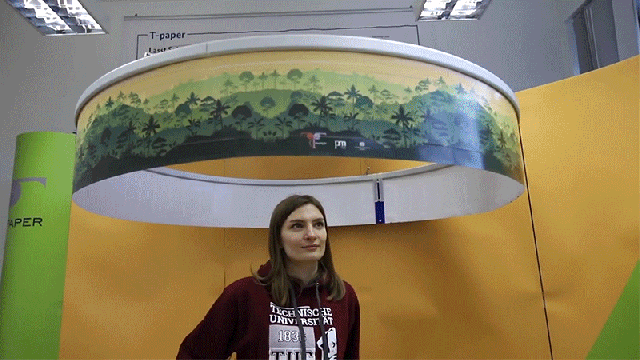A proper surround sound setup usually involved a room filled with boxy speakers in every corner, but researchers at Germany’s Chemnitz University of Technology have developed a way to print long strips of paper loudspeakers that can be rolled up into a 360-degree surround sound experience more immersive than even a movie theatre.
The research, conducted at the university’s Institute for Print and Media Technology, is actually a follow-up to a project created back in 2015 called the T-Book. What looked like a large coffee table book full of beautiful black and white photos was actually a fairly elaborate experiment in flat speaker technology as each page of the book produced sounds to accompany the photographs.

The printing process involved covering two layers of paper or foil with a conductive organic polymer which served as electrodes, and then in-between was sandwiched an equally thin piezoelectric layer which would cause the finished sheet to vibrate like a speaker cone, moving air and producing audible sounds. The printing process could only produce individual sheets and was extremely slow, however, limiting the practical uses and applications of an, otherwise, innovative technology.
Almost six years later, with the help of experts in various fields from six other countries, the Chemnitz University of Technology researchers have developed a new printing process, detailed in a paper recently published in the Advanced Materials journal, that can quickly and reliably churn out the paper-thin speakers in long sheets, so they can be potentially mass-produced and made available for consumer applications at a competitive price to existing speaker technologies.
Using an existing method known as the roll-to-roll printing process which is used to create other flexible electronics, the paper-thin speaker material can be created in one continuous process including the lamination of the various layers leaving the critical electronics completely sealed and protected from damage — to a degree. To demonstrate the results, a strip almost four meters long was produced containing 56 individual speaker elements. It was then rolled into a cylinder and suspended from the ceiling. The whole thing weighed in at just 150 grams and was made from 90% regular old paper that even featured a colourful printed design on the outside, although imagery can actually be applied to both sides.
Someone standing inside or beneath the cylinder is able to hear sounds, but someone standing on the outside, nearby, would be hard-pressed to hear anything. As a result, there’s some unique potential for this technology when it comes to serving as an informational display at a museum, or even as advertising in a store that delivers more than just images and text. A radio ad for a given product could be played as someone stands near it. One day entire walls covered in sound-producing wallpaper could be a thing, resulting in a home theatre surround sound setup that’s completely invisible to the eye.
